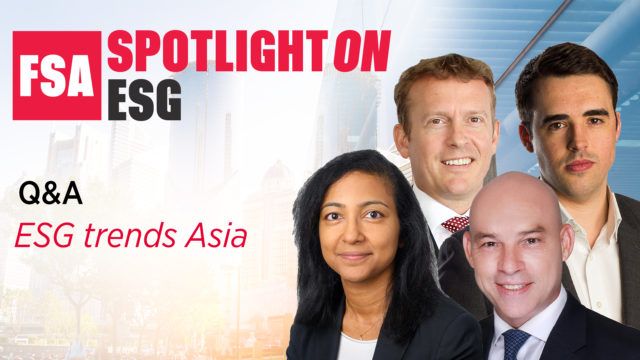In Asia, what are the main challenges for investors when adopting ESG/Green and sustainable investing? Is there still confusion among investors about the different concepts about SRI/ESG/Green and sustainability/impact investing?

Director, FSSA Investment Managers
Alistair: I don’t believe the challenges in Asia are any different from the rest of the world. Different companies are using different data sets and transparency continues to be a challenge. We are encouraging companies to adopt SASB (Sustainable Accounting Standards Board) methodologies, which if successful should provide some commonality. Some companies can be suspicious of collaborative engagement, so it we must reassure companies that we are on their side and are looking for profitable solutions to ESG challenges. As has always been the case it is critical that we do our own research rather than relying on research providers who often apply a one size fits all approach which may not provide the full picture.
The different concepts of SRI, ESG, sustainability and impact investing continue to confuse investors in Asia, although impact investing is perhaps better understood.

Senior Credit Portfolio Manager, Federated Hermes
Nachu: Asia is in different stages of “ESG” maturity across its various markets, with some countries ahead of others. At the moment, there is no homogeneous understanding of the different ESG concepts across the region. But even in Western markets, where ESG and sustainability concepts are more advanced, the same challenges of universal definitions exist, so this is not just a problem for Asia.
That said, the market continues to evolve and we are seeing a rising demand for sustainability and impact investing as investors get to understand the different concepts of ESG. All of these concepts are part of a broader approach to responsible investing. For example, socially responsible investing (SRI) is more values-based, while ESG is investing taking into account non-fundamental along with operating and financial risks into the investment process. Sustainability is investing with a social and environmental outcome in addition to a financial outcome, while impact investments make use of capital for a purpose.

John: It can still be challenging to differentiate between investment strategies with a genuine sustainability focus and those that may be ‘greenwashing’. The good news is that various stakeholders – including regulators, data providers, asset managers and investors – are working to improve matters. For instance, some regulators are establishing frameworks to define and classify sustainable investments, strengthen market oversight and improve disclosures. That will increasingly assist investors to make better-informed decisions.
It’s also helpful that the volume of sustainability-related data available continues to increase, though it can be difficult for even professional investors to navigate the large number of data providers and variety of methodologies used for assessing companies and funds. I think many investors and asset managers hope for more standardised ratings in the future to make it easier to compare investment products.
Regarding the different terms currently in use, there is still confusion, not least because there are no universal definitions of “SRI”, “ESG”, “green” or “sustainable” investing. So it’s crucial for investors to look at the composition of a portfolio, understand the investment process and pay attention to how a manager engages with companies, because investment products that may share a “sustainable” label can be very different.

Harry: Sustainable investing is becoming a much more important consideration for investors in Asia. Around 79% of investors in Asia-Pacific increased ESG investments “significantly” or “moderately” in response to Covid-19, according to the MSCI 2021 Global Institutional Investor survey. The increasing interest in ESG reflects investor concerns that many companies are facing growing ESG risks. Notwithstanding the 7% fall in global CO2 emissions in 2020 due to widespread economic lockdowns, we continued to see physical climate risks materialising at an accelerating pace – after years with sporadic droughts and water scarcity, Southeast Asia experienced massive flooding and large-scale crop damage, while in Taiwan we are currently seeing water shortages. Covid-19 also heightened ESG risks for companies that entered the downturn with stretched balance sheets, raising the risk of equity dilution and related party transactions. Corporates have responded to the crisis by cutting their capital expenditure and headcount, thus increasing the likelihood of adverse health and safety outcomes and reputational risk.
Investors have become much more sophisticated about the distinction between SRI and ESG and sustainable/impact investing, driven both by regulations and institutions. Corporate governance and stewardship codes and stock exchange requirements have raised the standards of both governance and disclosure in Asia. Japan’s Government Pension Investment Fund started allocating into ESG indices in 2017, following this move with a further allocation into low-carbon indices in 2018. Finally, we anticipate that the younger generations of many ultra-high-net-worth families will give far higher credence to making a positive impact in the world, including through their investments.
As ESG becomes more mainstream with most fund managers starting to integrate ESG factors in their investment process (driven by investor demand and regulation), do you think that ESG will no longer be a differentiating factor in five-to-10 years?

Director, FSSA Investment Managers
Alistair: Yes, I do believe that will be the case.

Senior Credit Portfolio Manager, Federated Hermes
Nachu: The difference will likely shift from the mere fact of managers integrating ESG into their investment process, which all likely will, to how well they do it, how well it is embedded in the culture of the firm, how well they have adapted to all the data, technology, tools, intellectual capital available, and how much of their approach is proprietary.

John: For most asset managers, integrating ESG into investment processes is aimed at managing risks and capturing potential return opportunities linked to ESG factors. But the way they integrate ESG, and the extent to which they do so, vary enormously.
At Ninety One, we think about our investments holistically and believe that ESG analysis should be integrated across all strategies and asset classes. This is consistent with our long-term approach to allocating capital. In 5-10 years, it may be that ESG is no longer discussed separately when analysing an investment process. But there will still be wide variation in fund managers’ skill at identifying, evaluating and pricing environmental, social and governance factors. So it will continue to be crucial for investors to assess a fund manager’s investment process with respect to ESG – perhaps even more so. For companies and investors, the focus on sustainability is unlikely to go away. After all, the climate crisis is very unlikely to be solved by 2030, and I think the pandemic has made everyone much more aware of their broader responsibilities to society.

Harry: ESG is still going to be a differentiating factor in the medium-term because not everyone can integrate ESG factors well. ESG has to focus on financial materiality, which requires the ability to link between ESG and investing. Furthermore, many believe that disclosure is a critical factor; however, disclosure does not equal outcomes.
The Fund Selector Asia Spotlight On: ESG will run on 22 – 25 March and ends with a LIVE event (on the 25th) where we will bring together a panel of fund selectors and the fund managers to discuss their views and join an interactive Q&A session.
Find out more about our Spotlight On: ESG here: https://fundselectorasia.com/spotlight-on/esg/

















